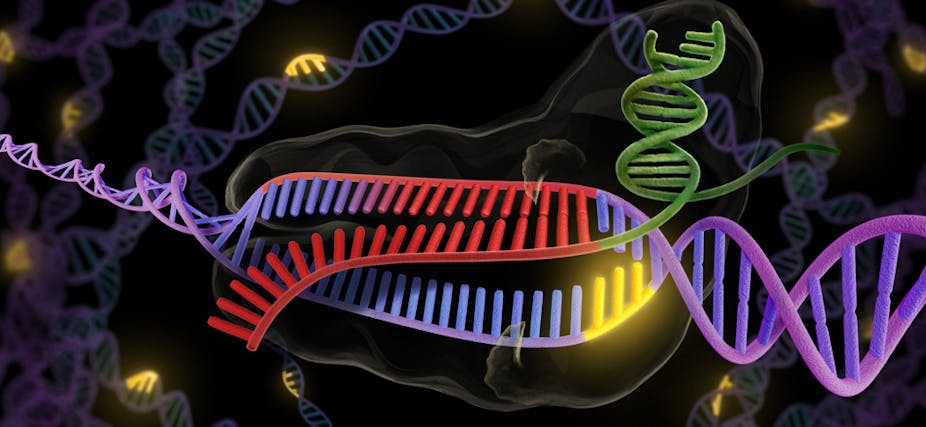A group of leading biologists earlier this month called for a halt to the use of a powerful new gene editing technique on humans. Known by the acronym CRISPR, the method allows precise editing of genes for targeted traits, which can be passed down to future generations.
With this explainer, we’ll look at where this technique came from, its potential and some of the issues it raises.
Surgical precision
CRISPR stands for clustered regularly interspaced short palindromic repeats, which is the name for a natural defense system that bacteria use to fend off harmful infections.
Bacteria are infected by other microorganisms, called bacteriophages, or phages. The intricate details of the mechanism were elucidated around 2010 by two research groups led by Dr Doudna of the University of California Berkeley and Dr Charpentier of Umeå University in Sweden.
The CRISPR system recognizes specific patterns of DNA from the foreign invaders and decapacitates them by cutting the invader’s DNA into pieces. The way that the bacteria target specific DNA and cleave it gave scientists a hint of its potential in other applications.
In 2013, two research groups, one lead by Dr Zhang of Massachusetts of Institute of Technology and the other by Dr Church of Harvard University, successfully modified this basic mechanism and turned it into a powerful tool that can now cut human genomic DNA at any desired location.
The ability to cut DNA or genes at specific locations is the basic requirement to modify the genome structure. Changes can be made in the DNA around the cleavage site which alter the biological features of the resulting cells or organisms. It is the equivalent of a surgical laser knife, which allows a surgeon to cut out precisely defective body parts and replace them with new or repaired ones.
Tool for gene discovery
Scientists have long sought after this sort of genome editing tools for living cells. Two other technologies, called zinc-finger nucleases and TALEN (transcription activator-like effector nuclease) are available to achieve the same result. However, the CRISPR technology is much easier to generate and manipulate. This means that most biological research laboratories can carry out the CRISPR experiments.
As a result, CRISPR technology has been quickly adopted by scientists all over the world and put it into various tests. It has been demonstrated to be effective in genome editing of most experimental organisms, including cells derived from insects, plants, fish, mice, monkeys and humans.
Such broad successes in a short period of time imply we’ve arrived at a new genome editing era, promising fast-paced development in biomedical research that will bring about new therapeutic treatments for various human diseases.

The CRISPR technology offers a novel tool for scientists to address some of the most fundamental questions that were difficult, if not impossible, to address before.
For instance, the whole human genomic DNA sequence had been deciphered many years ago, but the majority of information embedded on the DNA fragments are largely unknown. Now, the CRISPR technology is enabling scientists to study those gene functions. By eliminating or replacing specific DNA fragments and observing the consequences in the resulting cells, we can now link particular DNA fragments to their biological functions.
Recently, cells and even whole animals with desired genome alterations have successfully been generated using the CRISPR technology. This has proven highly valuable in various biomedical research studies, such as understanding the cause and effect relationship between specific DNA changes and human diseases. Studying DNA in this way also sheds light on the mechanisms underlying how diseases develop and provides insights for developing new drugs that eliminate specific disease symptoms.
With such profound implications in medical sciences, many biotech and pharmaceutical companies have now licensed the CRISPR technology to develop commercial products.
For example, a biotech company, Editas Medicine, was founded in 2013 with the specific goal of creating treatments for hereditary human diseases employing the CRISPR technology.
However, products derived from the use of CRISPR technology are yet to hit the market with FDA approval.
Call for ethical guidelines
With the CRISPR technology, scientists can now alter the genome composition of whole organisms, including humans, through manipulating reproductive cells and fertilized eggs or embryos. Those particular genetic traits are then passed down through generations. This brings hope to cure genetic defects that cause various hereditary human diseases, such as cystic fibrosis, haemophilia, sickle-cell anemia, Down syndrome and so on.
Unlike the current approaches of gene therapy which temporarily fix defective cells or organs through the introduction of corrected or functional genes, the CRISPR technology promises to correct the defect in the reproductive cells, producing progenies that are free of the defective gene. In other words, it can eliminate the root causes of hereditary human diseases.

In theory,then, hereditary features that people consider advantageous, such as higher intelligence, better body appearance and longevity, can be introduced into an individual’s genome through CRISPR mediated reproductive cell modifications as well.
However, scientists do not yet fully understand all the possible side effects of editing human genomes. It is also the case, that there is no clear law to regulate such attempts.
That’s why groups of prominent scientists in the field have recently initiated calls for ethical guidelines for doing such modifications of reproductive cells. The fear being that uncontrolled practice might bring about unforeseen disastrous outcomes in long run.
The guidelines call for a strong discouragement of any attempts at genome modification of reproductive cells for clinical application in humans, until the social, environmental, and ethical implications of such operations are broadly discussed among scientific and governmental organizations.
There is no doubt that the exciting and revolutionary CRISPR technology, under the guidance of carefully drafted and broadly accepted rules, will serve well for the well-being of human kind.

